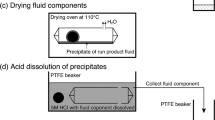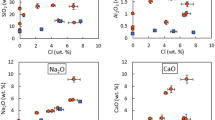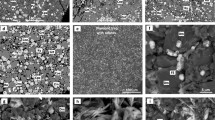Abstract
The mobility of trace elements in supercritical fluid-melt derived from pelite rich in volatiles has been studied experimentally at pressures from 3.0 to 7.8 GPa and temperatures from 750 to 1090 °С using the diamond trap method. The experiments simulate the conditions of warm and hot subduction, in which pelite either retains the whole inventory of volatiles or releases a fluid in three successive devolatilization steps. The 3.0 GPa and 750 °С runs with pelite rich in volatiles yield a supercritical fluid (SCF) which attains equilibrium with an eclogitic residue bearing phengite and accessory rutile, zircon, and monazite. At ≥5.5 GPa and ≥850 °С, above the second critical endpoint, the SCF transforms into a supercritical fluid-melt (SCFM) which acquires higher concentrations of almost all incompatible trace elements while the mineral assemblage of the equilibrium eclogitic residue remains the same but lacks monazite. The trace-element enrichment of SCFM is most prominent for Ba, Sr, LREE, Th, and U. At the hot subduction conditions, the fluid-melt likewise contains more K, Rb, Zr, and Hf, though LREE contents become lower. The negative Nb anomaly persists in all cases. SCFM has its trace-element composition generally similar to that of hydrous melt derived from oceanic sediments, but contains more REEs and water. Partitioning of LILE, HFSE, and LREE between the SCFM and residue phases mainly depends on the fluid-melt fraction and stability of host phengite, monazite, zircon, and rutile. Thus, sediment-derived SCFM can carry both fluid-mobile and sediment-melt elements to regions of arc- and back-arc magma generation and can translate the negative Nb anomaly inherited from sediment into the magmas. Early devolatilization of pelite increases the stability of monazite and phengite in the residue and provides efficient LREE, K and Rb transport to the mantle depths of ~ 250 km. Effective LREE and Th depletion of UHP metamorphic rocks is possible by SCFM release near peak metamorphic conditions.








Similar content being viewed by others
References
Ayers J (1998) Trace element modeling of aqueous fluid–peridotite interaction in the mantle wedge of subduction zones. Contrib Mineral Petrol 132:390–404
Ayers JC, Dittmer SK, Layne GD (1997) Partitioning of elements between peridotite and H2O at 2.0–3.0 GPa and 900–1100 C, and application to models of subduction zone processes. Earth Planet Sci Lett 150(3–4):381–398
Bebout GE (2014) Chemical and isotopic cycling in subduction zones. Treatise Geochem 4:703–747
Brenan J, Shaw H, Ryerson F, Phinney D (1995) Mineral-aqueous fluid partitioning of trace elements at 900◦C and 2.0 GPa: constraints on the trace element chemistry of mantle and deep crustal fluids. Geochim Cosmochim Ac 59:3331–3350
Carter LB, Skora S, Blundy J, De Hoog J, Elliott T (2015) An experimental study of trace element fluxes from subducted oceanic crust. J Petrol 56:1585–1606
Elliott T (2003) Tracers of the Slab. Geophys Monograph-American Geophys Union 138:23–46
Elliott T, Plank T, Zindler A, White W, Bourdon B (1997) Element transport from slab to volcanic front at the Mariana arc. J Geophys Res Solid Earth 102:14991–15019
Green TH, Adam J (2003) Experimentally-determined trace element characteristics of aqueous fluid from dehydrated mafic oceanic crust at 3.0 GPa, 650–700°C. Eur J Mineral 15:815–830
Hayden LA, Watson EB (2007) Rutile saturation in hydrous siliceous melts and its bearing on Ti-thermometry of quartz and zircon. Earth Planet Sci Lett 258(3–4):561–568
Hermann J, Rubatto D (2009) Accessory phase control on the trace element signature of sediment melts in subduction zones. Chem Geol 265:512–526. https://doi.org/10.1016/j.chemgeo.2009.05.018
Hermann J, Rubatto D (2014) Subduction of continental crust to mantle depth: geochemistry of ultrahigh-pressure rocks. In Treatise on Geochemistry, 2nd Edition. Elsevier
Hermann J, Spandler CJ (2008) Sediment melts at sub-arc depths: an experimental study. J of Petrol 49:717–740. https://doi.org/10.1093/petrology/egm073
Hermann J, Zheng YF, Rubatto D (2013) Deep fluids in subducted continental crust. Elements 9:281–287. https://doi.org/10.2113/gselements94281
Hicks SP, Bie L, Rychert CA, Harmon N, Goes S, Rietbrock A, VoiLA Working Group (2023) Slab to back-arc to arc: fluid and melt pathways through the mantle wedge beneath the Lesser Antilles. Sci Adv 9(5):eadd2143
Ionov D, Harmer RE (2002) Trace element distribution in calcite-dolomite carbonatites from Spitskop: inferences for differentiation of carbonatite magmas and the origin of carbonates in mantle xenoliths. Earth Planet Sci Let 198:495–510
Johnson MC, Plank T (1999) Dehydration and melting experiments constrain the fate of subducted sediments. Geochem Geophys Geosyst 1:1007. https://doi.org/10.1029/1999GC000014
Keppler H (2017) Fluids and trace element transport in subduction zones. Am Mineral 102:5–20. https://doi.org/10.2138/am-2017-5716
Kessel R, Ulmer P, Pettke T, Schmidt MW, Thompson AB (2004) A novel approach to determine high-pressure high-temperature fluid and melt compositions using diamond-trap experiments. Am Mineral 89(7):1078–1086
Kessel R, Schmidt MW, Pettke T, Ulmer P (2005a) Trace element signature of subduction-zone fluids melts and supercritical liquids at 120–180 km depth. Nature 437:724–727
Kessel R, Ulmer P, Pettke T, Schmidt MW, Thompson AB (2005b) The water-basalt system at 4 to 6 GPa: phase relations and the second critical endpoint in a K-free eclogite at 700–1400°C. Earth Planet Sci Lett 237:873–892
Klimm K, Blundy JD, Green TH (2008) Trace element partitioning and accessory phase saturation during H2O-saturated melting of basalt with implications for subduction zone chemical fluxes. J Petrol 49:523–553
Li H, Hermann J, Zhang L (2022) Melting of subducted slab dictates trace element recycling in global arcs. Sci Adv 8(2):eabh2166
Manning CE (2004) The chemistry of subduction-zone fluids. Earth Planet Sci Lett 223:1–16
Massonne HJ, Kennedy A, Nasdala L, Theye T (2007) Dating of zircon and monazite from diamondiferous quartzofeldspathic rocks of the Saxonian Erzgebirge – hints at burial and exhumation velocities. Mineral Mag 71:407–425
McDonough WF, Sun SS (1995) The composition of the Earth. Cheml Geol 120(3–4):223–253
Ni H, Zhang L, Xiong X, Mao Z, Wang J (2017) Supercritical fluids at subduction zones: evidence, formation condition, and physicochemical properties. Earth Sci Rev 167:62–71
Plank T, Langmuir CH (1998) The chemical composition of subducting sediment and its consequences for the crust and mantle. Chem Geol 145(3–4):325–394
O’Reilly SY, Griffin WL (2013) Mantle Metasomatism. In: Harlov DE, Austrheim H (eds) Metasomatism and the Chemical Transformation of Rock. Springer-, Berlin Heidelberg, pp 471–533
Palyanov YN, Kupriyanov IN, Khokhryakov AF, Borzdov YM (2017) High-pressure crystallization and properties of diamond from magnesium-based catalysts. CrystEngComm 19:4459–4475 https://doi.org/10.1039/C7CE01083D
Pearce JA, Stern RJ (2006) Origin of back-arc basin magmas: Trace element and isotope perspectives. Back‐arc spreading systems: geological, biological, chemical. Phys Interact 166:63–86
Pearce JA, Stern RJ, Bloomer SH, Fryer P (2005) Geochemical mapping of the Mariana arc-basin system: implications for the nature and distribution of subduction components. Geochem Geophys Geosyst 6:Q07006
Perchuk AL, Serdyuk AA, Zinovieva NG, Shur MY (2020) Melting and parageneses of global subducting water-enriched sedi- ment in closed and open systems: experiment and thermodynamic modeling. Russ Geol Geophys 61(5–6):571–591. https://doi.org/10.15372/RGG2019177
Petrichenko YA (2000) Geochemical characteristics of organic matter in the Maikop series of the Kerch-Taman trough. Mosc Univ Bull Ser 4:6:64–66 (in Russian)
Plank T (2014) The chemical composition of subducting sediments. in: Holland HD, Turekian KK (Eds) Treatise on Geochemistry, Elsevier, Amsterdam, pp 607–629. https://doi.org/10.1016/B978-0-08-095975-700319-3
Plank T, Manning CE (2019) Subducting carbon. Nature 574:343– 352. https://doi.org/10.1038/s41586-019-1643-z
Portnyagin M, Hoernle K, Plechov P, Mironov N, Khubunaya S (2007) Constraints on mantle melting and composition and nature of slab components in volcanic arcs from volatiles (H2O, S, cl, F) and trace elements in melt inclusions from the Kamchatka Arc. Earth Planet Sci Lett 255(1–2):53–69
Ruscitto DM, Wallace PJ, Cooper LB, Plank T (2012) Global variations in H2O/Ce: 2. Relationships to arc magma geochemistry and volatile fluxes. Geochem Geophys Geosyst 13:Q03025
Rustioni G, Audétat A, Keppler H (2019) Experimental evidence for fluid-induced melting in subduction zones. Geochem Persp Let 11:49–54
Rustioni G, Audetat A, Keppler H (2021) The composition of subduction zone fluids and the origin of the trace element enrichment in arc magmas. Contrib Mineral Petrol 176(7):51
Ryabchikov ID, Orlova GP, Kalenchuk GYu, Ganeev II, Udovkina NG, Nosik LP (1989) Interaction of spinel lherzolite with water–CO2 fluid at 20 kbar and 900°C. Geokhimiya 3:385–392 (in Russian)
Schmidt M, Poli S (2014) Devolatilization during subduction. In: Holland HD, Turekian KK (ed), Treatise on Geochemistry, Elsevier, Amsterdam, pp 669–701. https://doi.org/10.1016/B978-0-08-095975-700321-1
Schmidt MW, Vielzeuf D, Auzanneau E (2004) Melting and dissolution of subducting crust at high pressures: the key role of white mica. Earth Planet Sci Lett 228:65–84. https://doi.org/10.1016/j.epsl.2004.09.020
Shatsky VS, Jagoutz E, Sobolev NV, Kozmenko OA, Parkhomenko VS, Troesch M (1999) Geochemistry and age of ultrahigh pressure metamorphic rocks from the Kokchetav massif (Northern Kazakhstan). Contrib Mineral Petrol 137:185–205
Shatsky VS, Sitnikova ES, Koz’menko OA, Palessky SV, Nikolaeva IV, Zayachkovsky AA (2006) Behavior of incompatible elements during ultrahigh-pressure metamorphism (by the example of rocks of the Kokchetav massif). Russ Geol Geophys 47(4):485–498
Shatsky VS, Skuzovatov SYu, Ragozin AL, Sobolev NV (2015) Mobility of elements in a continental subduction zone: evidence from the UHP metamorphic complex of the Kokchetav massif. Rus Geol Geophys 56(7):1016–1034
Skora S, Blundy J (2010) High-pressure hydrous phase relations of radiolarian clay and implications for the involvement of subducted sediment in arc magmatism. J Petrol 51:2211–2243. https://doi.org/10.1093/petrology/egq054
Skora S, Blundy JD, Brooker RA, Green ECR, de Hoog JCM, Connolly JAD (2015) Hydrous phase relations and trace element partitioning behaviour in calcareous sediments at subduction-zone conditions. J Petrol 56:953–980
Sokol AG, Borzdov YM, Palyanov YN, Khokhryakov AF (2015) High-temperature calibration of a multi-anvil high pressure apparatus. High Pressure Res 35(2):139–147. https://doi.org/10.1080/0895795920151017819
Sokol E, Kokh S, Kozmenko O, Novikova S, Khvorov P, Nigmatulina E, Belogub E, Kirillov M (2018) Mineralogy and geochemistry of mud volcanic ejecta: a new look at old issues (a case study from the Bulganak field Northern Black Sea). Minerals 8(344). https://doi.org/10.3390/min8080344
Sokol AG, Kozmenko OA, Kruk AN (2023a) Composition of supercritical fluid in carbonate-and chlorine-bearing pelite at conditions of subduction zones. Contrib Mineral Petrol 178(12):90
Sokol AG, Koz’menko OA, Kruk AN, Nechepurenko SF (2023b) Composition of the fluid in carbonate- and chlorine-bearing pelite near the second critical point: results of diamond trap experiments. Russ Geol Geophys 64:1–13
Spandler C, Pirard C (2013) Element recycling from subducting slabs to arc crust: a review. Lithos 170:208–223
Spandler C, Mavrogenes J, Hermann J (2007) Experimental constraints on element mobility from subducted sediments using high-P synthetic fluid/ melt inclusions. Chem Geol 239:228–249
Stepanov AS, Hermann J, Korsakov AV, Rubatto D (2014) Geochemistry of ultrahigh-pressure anatexis: fractionation of elements in the Kokchetav gneisses during melting at diamond-facies conditions. Contrib Mineral Petrol 167:1002
Turner SJ, Langmuir CH (2022) Sediment and ocean crust both melt at subduction zones. Earth Planet Sci Lett 584:117424
Westrenen WV, Blundy J, Wood B (1999) Crystal-chemical controls on trace element partitioning between garnet and anhydrous silicate melt. Am Mineral 84(5–6):838–847
Zheng YF, Hermann J (2014) Geochemistry of continental subduction-zone fluids. Earth Planets and Space 66(1):1–16
Acknowledgements
We would like to thank Yu. Palyanov, Yu. Borzdov, and A. Khokhryakov for their assistance throughout the study. The manuscript profited much from thoughtful reviews by John C. Ayers and anonymous reviewer. The research was supported by the Russian Science Foundation (grant No. 22-17-00005). The EDS-SEM and EMPA studies of experimental samples were performed in the Analytical Center for Multi-element and Isotope Research (Novosibirsk). The ICP-MS studies at the Center for Isotopic and Geochemical Research (Irkutsk) were supported by the Russian Science Foundation (grant No. 21-77-10038, https://rscf.ru/project/21-77-10038) and the analytical work at the Zavaritsky Institute of Geology and Geochemistry (Ekaterinburg) was carried out as part of government assignment No. 123011800012-9.
Author information
Authors and Affiliations
Corresponding author
Additional information
Communicated by Dante Canil.
Publisher’s Note
Springer Nature remains neutral with regard to jurisdictional claims in published maps and institutional affiliations.
Electronic supplementary material
Below is the link to the electronic supplementary material.
Rights and permissions
Springer Nature or its licensor (e.g. a society or other partner) holds exclusive rights to this article under a publishing agreement with the author(s) or other rightsholder(s); author self-archiving of the accepted manuscript version of this article is solely governed by the terms of such publishing agreement and applicable law.
About this article
Cite this article
Sokol, A., Kozmenko, O., Kruk, A. et al. Trace-element mobility in pelite-derived supercritical fluid-melt at subduction-zone conditions. Contrib Mineral Petrol 179, 50 (2024). https://doi.org/10.1007/s00410-024-02131-2
Received:
Accepted:
Published:
DOI: https://doi.org/10.1007/s00410-024-02131-2




